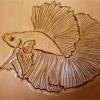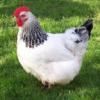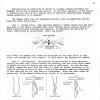-
Posts
941 -
Joined
-
Last visited
Content Type
Profiles
Forums
Events
Blogs
Gallery
Everything posted by gottaknow
-

Singer 111W155 Timing/thread Issues
gottaknow replied to TSquared's topic in Leather Sewing Machines
Thanks for the kind words Darren. I just think when I'm done and gone that it would be a shame if I didn't share stuff to help folks. I'm paid well in the factory, so I have nothing to gain by keeping everything to myself. It's like everything else mechanical. If you learn each parts of a machine and how they work together, a lot of people can take care of issues themselves. There's nothing special about me, I've just done it since 1980. Regards, Eric -

Singer 111W155 Timing/thread Issues
gottaknow replied to TSquared's topic in Leather Sewing Machines
We're doing a lot of samples for them right now for all of their jeans. We hope to start denim production in the next two weeks, having completed those samples a bit ago. I can't vouch for others that have sewn for them, but I can tell you ours will be of superior quality. We were a Levi contractor for years. We could easily end up being their main jeans contractor. We are working on courderoy samples now, which present a unique set of problems for the machines, but they look good. Regards, Eric -

How To Remove Bobbin Case On Singer 112W116
gottaknow replied to Mark842's topic in Leather Sewing Machines
It's amazing how tight that can get. Another trick that I've used is to remove the screws and the "gib" (that flat curved piece) get a decent pair of needle nose pliers and grab whatever hunk of thread you can. (Nothing Metal!) Keep tension on the pliers and turn the handwheel back and forth. The hunk you have a hold of will likely give some and you can pull out enough to free the basket. Removing that basket is a good basic thing to learn. Regards, Eric -

How To Remove Bobbin Case On Singer 112W116
gottaknow replied to Mark842's topic in Leather Sewing Machines
You can remove the basket by removing 2 small screws on the little curved flat piece I've circled on the pic. This is actually a 112 with the throat plate and feed dogs removed. You'll need a short but good screwdriver as those little devils can be very tight. Remove the screws, slide the curved piece out. I hold the basket with my fingers (no plier zone) and rock the wheel back and forth until you can rotate it far enough to pop it out. Give the hooks a drop of oil each time you use your machine, right along where the basket spins in the hook. Regards, Eric -

Singer 111W155 Timing/thread Issues
gottaknow replied to TSquared's topic in Leather Sewing Machines
I've got the dogs and plate and bar. What kind of shape are your feed dog screws in? I've also got the small screw and guide for your bar. Regards, Eric -

Singer 111W155 Timing/thread Issues
gottaknow replied to TSquared's topic in Leather Sewing Machines
When sewing thicker material, your tension release pin may be opening your tension disks just enough to loosen your top tension. If you're going to consistantly sew thicker stuff, you'll want to check that. Most Singer manuals tell you to set the pressure just tight enough to feed properly. I sew on scrap with the pressure starting out loose then tighten as needed. The machine does have a limit which will vary greatly depending on the type of leather as to the thickness. Understanding the adjustments and not being shy about trying different settings will benefit you in the long run. Both you and Tom have a much better understanding of how your machines work. Long term, this is essential for you to get the most out of them. As a side note in regards to the tension releasing. Some new machines have the option of taking out the pin that releases the tension and using a manual tension release that's mounted on the front of the machince. Juki and Mitsubishi both have that feature which is nice. Regards, Eric -
Lol Darren. The machine has a cool shape to it, but it's been beat up some. I have plenty of machines to sew on, so I may strip this one down to the casting and do a complete restoration. I'll get some pictures of it this weekend. It for sure has "character". Regards, Eric
-

Singer 111W155 Timing/thread Issues
gottaknow replied to TSquared's topic in Leather Sewing Machines
Hey Tom, Yeah, we'll be making jeans again as soon as we finish the size run samples. In the past we've made Levi's and jeans for The Gap. Those are all imported now. The company we'll be contracting for is Bills Khakis. They are located in PA. I do know they go up to a 46. Ours will hit their warehouse in late winter I imagine. There are still companies willing to do business in the US, and customers willing to pay the higher price. We'll likely become there main jeans contractor. Could you check the part number on those feed dogs? I believe I have a set but want to verify. I also have a plate to match. I absolutely won't accept a dime for the parts. The dogs and plate are used but in great condition, honestly, they will never be used. I'll check for a needle bar tommorow, time permitting. What shape are your feed dog screws in? Regards, Eric -
I traded some sewing machine labor at a drape shop for an old Consew 18. Most of the parts are there. No table or motor, but I have a lot of those. I should be getting it this weekend. I'm thinking it will do some nice medium weight leather. It's kinda ugly though. Regards, Eric
-

Singer 111W155 Timing/thread Issues
gottaknow replied to TSquared's topic in Leather Sewing Machines
I'll get into my "I'll never use all of these" drawers and see whats there tommorow if I have time. I'm setting up a jeans line for the next few weeks, but I'll start digging around for you. I'm thinking the 211W151 comes out the top as they don't have a walking foot. I could have been thinking of a Singer 281, 300W, 269w, 230g, yikes..too many numbers in my head! Singer has their own thread standards for the majority of the screws. I have over the years found other mfgs will do in a pinch. Measure the length of your needle bar for me when you get a chance and I'll need a pic and demensions of your throat plate. A part number would do if it's still there. Here's a 211 I rebuilt for a local upholsterer and a Consew 327RB I overhauled to set headers on the flags we produce. It's a clone of the Singer 212 which is basicaly a 211 with another hook. Regards, Eric -
I was going to work on a couple of wallets today, but ended up making a couple fleece jackets for our 9 month old grandson instead. Still a few weeks I guess..heh
-

Thread Unravels In The Middle Of A Stitch
gottaknow replied to Andrew Chee's topic in Leather Sewing Machines
If you're using the same thread on multiple machines, it's likely the thread. Here's a pretty decent explanation of thread behavior that I've attached as a pic. Unless all your machines hooks are dull or poorly adjusted, I'd look at your thread first. Regards, Eric -

Juki 1541S Oil On Fabric And Thread
gottaknow replied to csteel24's topic in Leather Sewing Machines
Welcome Martin! I'm thinking you need to turn your hook oiler down a bit at a time until it stops throwing oil. Tip the machine back and look for a small nut that locks down a small screw, very close on the casting where the hook shaft is. Loosen the jam nut and turn the screw counter clockwise 1/4 turn. Tighten the nut and then sew for a while. It will take time for the oil return wicks to get rid of your excess oil. It actually takes very little oil to keep the hook running smooth. Your bobbin case can get a little warm to the touch and that's ok. If it gets hot, turn your oiler back up. Keep adjusting until you get it where you want. There will always be a little oil in the neighborhood, but it shouldn't be getting on your material. Also, when you're not sewing, get in the habit of sewing a piece of cotton and leaving it under the foot. This will help keep your working surface cleaner. And have fun! Regards, Eric -

Singer 111W155 Timing/thread Issues
gottaknow replied to TSquared's topic in Leather Sewing Machines
The bar is easy to replace. I'd be sure it needs to be first. If your machine is timed right, you can use your hook point for a height reference. You can also measure the distance of the between the top of the throat plate and the point of the needle with the bar all the way up. There is a clamp on the needle bar that secures it in place. It's easy to see from the end of the machine. You can check for trueness, including the needle holder without removing it from the machine. Start with a new needle and measure the height from the throat plate. Turn the needle bar down until the tip is just about to go through the feed dog hole. Loosen the clamp and rotate the bar. Using the hole in the dog, you'll see if it's out of true. This is a quick way to check a needle bar. I've seen my share of bent ones over the years, so if you're having trouble and you're sure the machine is timed right, check the bar. You'll still need to get those feed dogs loose at some point. We have at least 50 211's in storage, so you can imagine the parts inventory I'll never use. No charge for a new bar and set screw, and I imagine the postage would be just a couple of bucks. If your needle bar was ok to start with, certainly nothing wrong with a new one, but you'll still need to resolve any remaining issues. To remove your needle bar, take out the needle set screw and thread guide in your bar still has one. Loosen the clamp and slide the bar out the top of the machine. There's a hole for it, though you may need to rotate the machine a bit to line it up. Regards, Eric -
When I work outside, I wear a base layer of long underwear (closer to tights actually). The best fabric content by far is a blend of polyester/Lycra/and a bit of cotton. You create a dead air space next to your skin which will allow you to wear less bulky outerwear. We've made these products for years and they really are amazing if you've never tried them. If your feet get cold, I wear a pair of old Sorel (lots of Shoe Goo in places) with a piece of 9mm neoprene as an sole insert. Makes a big difference if you're standing or sitting with your feet on a cold floor. I had a locksmith friend in Alaska that actually wore skin diving boots inside his regular boots when it was really cold. Regards, Eric
-

Singer 111W155 Timing/thread Issues
gottaknow replied to TSquared's topic in Leather Sewing Machines
Verify you've got a good needle, and you're going to have to get those two screws loose. There is plenty of adjustment there as the two screws sit on flat spots and have larger holes to allow side to side adjustment. Granted, those screws can be a bugger, especially since most people use really poor screwdrivers. I've been using Snap On screwdrivers which have really hard tips. When they wear, I get them replaced for free. In the mean time, I use an 1/8" wide insert bit with a slotted head. I then use a 1/4" ignition wrench to turn the insert bit which you can get straight up and down on the screws. I also have a set of screwdrivers I've ground at different angles to reach screws you can't get straight on. Old allen wrenches make really good offset screwdrivers as well when ground to shape. I replace my most common allen wrenches twice a year, so there's always plenty available. Before you attempt to loosen them, tap the dogs from side to side which will loosen the screws a bit so you can get started. Oh, and if you by chance need a needle bar, I've got tons of orginal Singer ones I'll never use. Be happy to mail you one. Regards, Eric -

Singer 111W155 Timing/thread Issues
gottaknow replied to TSquared's topic in Leather Sewing Machines
Nicely done Dave. Regards, Eric -
Hey Joe. Either your top tension is too tight, or your bobbin tension is too loose. I usually start loosening before tightening, so loosen your top tension a little at a time until the stitch is balanced. You can also do a little of both. Tighten the bobbin tension a little and loosen the top a little. You'll figure it out in no time. Enjoy your new machine! Regards, Eric
-

Singer 111W155 Timing/thread Issues
gottaknow replied to TSquared's topic in Leather Sewing Machines
Btw, have I mentioned when you first start out, you should be holding your tail thread out the back of the foot until you've formed a few stitches? -

Singer 111W155 Timing/thread Issues
gottaknow replied to TSquared's topic in Leather Sewing Machines
The purpose of the take up lever is to "give" the hook enough slack to travel around the hook, pick up the bobbin thread, and then set the stitch at the top of the stroke. If your top and bottom shaft timing is off just one tooth, you'll have slack in the thread at the wrong time and it will "flop" anywhere it wants. If you turn the machine by hand and keep the slack out of the thread and it make a good stitch, your shaft timing is still off. The amount of stroke of the take-up lever is engineered to match the amount of thread it gives the hook. If the take-up lever is not coordinated with the hook, you'll have issues as you describe. There is no way the take-up can give your hook more thread than it requires. The order of timing the machine again is as follows. Take-up lever all the way up. I place my finger under it and push up as I turn the handwheel, making sure it's all the way up. Remember, one tooth off makes a big difference. Then refer to the timing mark on the lower shaft. It has to be exactly lined up. At this point, make sure your hook is down all the way. If your hook is too high, it can throw off your timing, making your needle bar too low if your set the point of the hook where it needs to be in the scarf of the needle. Turn the needle bar all the way down and then measure 3/32" rise. At this position, the point of the hook should be centered at the needle and 1/16" above the top of the eye. If your needle bar height is off, raise or lower it until it's where it needs to be. Check your latch opener adjustment as I've described earlier (if you can find it..heh) and make darn sure the threads pulling up clean. Trust me Dave, when you get your machine timed and set, you'll eliminate the issues you're having. I hate to sound redundant, but if you were my apprentice, I'd un-adjust everthing ten times until you could do it in your sleep. By the time we get done, you'll likely be able too. Regards, Eric -

Singer 111W155 Timing/thread Issues
gottaknow replied to TSquared's topic in Leather Sewing Machines
There is a relationship between stitch length, foot pressure, feed dog height. The first thing I'd check would be the height of your feed dogs. Normally, when the dogs are all the way up, the bottom of the "valleys" between the teeth should be level with the throat plate. Too low and you'll slip and mark up your material. Too high and you will create a condition called "back-feeding" Back-feeding occurs when the feed dogs rise above the throat plate while still traveling backwards. It's fairly easy to see, just by watching the motion with your needle unthreaded and no material. If this is happening, lower the feed dogs. Very seldom do you need to run your foot pressure all the way down. If you do, you may need to adjust the presser bar clamp to provide adequate pressure with less adjustment. The easiest way to check is with a piece of paper under the foot. Loosen your pressure up all the way. If there's still a slight tension against the paper, the adjustment is good. If the foot isn't touching the paper at all, you'll need to drop the presser bar down, hold a little pressure on it and tighten it back up. Be sure to keep the alignment as the bar will rotate when the clamp's loose. It is possible that the feed eccentric on the lower shaft is worn. At slow speed, the play doesn't allow the stitch length you have set. At higher speed, the cam will "throw" the feed mechanism farther, making a longer stitch. This is one of those things that's hard to determine without me sewing on it. Best way to proceed is to check the things above, and play with your pressure. The more you adjust things and see the results, the easier it will be to judge where your problem may be. Regards, Eric -
I've reattached your pic with red arrows pointing to the screws you need to loosen. To make it easier, put a few drops of machine oil to the inside edge between the gib and the bobbin basket. As Steve said, you don't want to lose those screws. I use a precise screwdriver for those and magnetize it with a rare earth magnet. The oil will help you rotate the basket some to remove the thread. This is a common occurance on verticle hook machines. Try not to use any tools when moving your bobbin basket around. The tread travels around the entire assembly and you don't want a nick from a screwdriver. If you have to remove it completely, it has a small range where it will come out. You'll need to hold the basket stationary and rotate the hook until it pops out. This is where the oil comes in handy. Regards, Eric
-

Singer 111W155 Timing/thread Issues
gottaknow replied to TSquared's topic in Leather Sewing Machines
Thanks Dave. A project like this is forth coming. I'm working on a written synopsis. Regards, Eric -

Singer 111W155 Timing/thread Issues
gottaknow replied to TSquared's topic in Leather Sewing Machines
Ok, here's the video to show the adjusment of the safety clutch. It could remove a bit of play for you Dave. Regards, Eric -

Singer 111W155 Timing/thread Issues
gottaknow replied to TSquared's topic in Leather Sewing Machines
Good luck with that Dave. I'll have the video waiting for you. Regards, Eric









